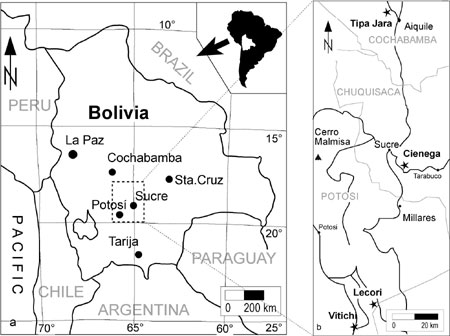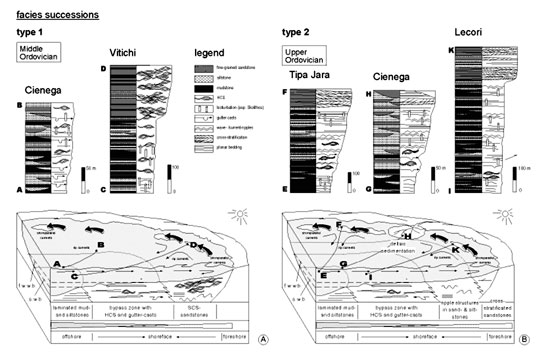
Middle to Upper Ordovician evolution of central Bolivia: a facies reevaluation
Claudia Hildebrandt1 and Sven O. Egenhoff1
1 Technische Universität Bergakademie Freiberg, Institut für Geologie, Bernhard-von-Cotta-Str. 2, D-09599 Freiberg, Germany. E–mail: Claudia.Hildebrandt@gmx.net / Sven.Egenhoff@geo.tu-freiberg.de
Key words: Facies. Stratigraphy. Depositional model. Ordovician. Bolivia.
Introduction
The sedimentology of central Bolivian Ordovician deposits has received little attention up to now. Some work has been done mainly focusing on lithostratigraphy (Suarez Soruco, 1976; Rodrigo and Castaños, 1978) but literature lacks a detailed facies documentation and interpretation. This study presents a depositional model for the central Bolivian shelf in the Middle and Late Ordovician. The investigations are based on detailed sedimentological logs in four localities (Cienega, Lecori, Tipa Jara and Vitichi) and observations throughout the study area (Figure 1).
Geological setting
During the Middle and Late Ordovician times, central to southern Bolivia was situated on the low-inclined eastern flank of a north-south trending foreland basin between the Brazilian Shield in the east and the approaching Arequipa-Belen-Antofalla Terrane in the west (Gohrbandt, 1992; Sempere, 1995; Bahlburg and Hervé, 1997). The siliciclastic infill of this basin is characterized by the more than 3000 km thick shallow-marine deposits of the Cochabamba Group (Suárez Soruco, 1992). This stratigraphic unit shows a pronounced shallowing-upward trend throughout Llanvirn to Ashgill times. However, it is composed of individual small-scale prograding sedimentary packages reflecting relative sea-level fluctuations. These will be addressed in the following chapters.
Description of facies
Two types of coarsening-upward units built up the central Bolivian Middle to Upper Ordovician successions: type (1) is characterized by an abrupt vertical change from pelites to sandstones with only a minor transitional facies. It is confined to Middle Ordovician intervals. type (2), in contrast, shows a gradational increase in grain-size and is restricted to Upper Ordovician strata. Both types are in the range of more than hundred to several hundreds of meters thick.

Figure 1. Map of Bolivia, showing the four localities discussed.
Type (1) These units occur in both, the lowermost part of the section Cienega and the locality Vitichi (Figure 2 A). In general, the basal part consists of dark grey bioturbated mudstones with up to 2 cm thick siltstone layers. The overlying intercalation of mud- and siltstones predominate within the unit. Typically, fine-grained sandstones are occasionally intercalated in the pelites as thin lenticular beds with a maximum thickness of 5 cm, as lenses with hummocky cross-stratification or as deep and narrow gutter casts. The transition to the overlying sandstones is characterized by a 15 m thick coarsening-upward trend with mud-, silt- and sandstone beds including HCS and gutter casts as well as planar bedding or ripple-stratification. The topmost sharp based HCS-sandstones consist of 4 to 10 m thick hummocky cross-stratificated beds separated by centimeter-thick pelitic intercalations.
Type (2) In the localities Cienega and Tipa Jara (Figure 2 B) the sections consist of several sandstone-dominated coarsening-upward units between 100 and 500 m thick. Although the Lecori section (Figure 2 B) is distinctively more pelitic it shows an equivalent vertical facies development. The basal part consists of laminated, usually intensively bioturbated mud- and siltstones. Towards the top, centimeter- to decimeter-thick fine-grained lenticular sandstone bodies with hummocky cross-stratification and ripple cross-lamination become increasingly abundant. Deep and narrow erosional structures cutting several centimeters to one decimeter into the laminated pelites are observed at the base of these sandstones. Bioturbation is moderate to intense occasionally leading to a destruction of internal bedding features and lithological stacking patterns.

Figure 2. Model of the Middle to Upper Ordovician shelf in central Bolivia based on the facies successions described in the text.
This facies grades vertically into a sand-dominated succession with only thin pelitic intercalations. The sandstones occur as elongated lenticular beds of several decimeters in thickness and show planar bedding with asymmetric or symmetric ripples on top. They are sometimes associated with fine-grained sandstones containing phosphatic fossil detritus and muddy lithoclasts. Bioturbation is generally intense. Therefore silty fine-grained sandbeds without or with only local preserved stratification are common. The uppermost part of the succession consists of up to 1 m thick lenticular sandbodies with internal planar or sigmoidal cross-bedding and erosive base. Ripple sets dip either to the north or to the west. One of these coarsening-upward units in the Cienega section is covered by channel-like structures in non-bioturbated laminated pelites. Within the whole unit bioturbation includes traces of Skolithos, Palaeophycus and Cruziana. Although Skolithos dominates in all facies types its abundance increases towards the top.
Interpretation of facies
Type (1) Grain size reflects depositional energy and therefore water depth as well as distance with respect to the shore-line. The dominance of laminated mudstones in the basal part of the unit is interpreted as distalmost facies and is characterized by sedimentation under low-energy conditions by suspension fall-out (Pickering et al., 1986). Millimeter-thick siltstone laminae have also been deposited by suspension-clouds, but the presence of ripple cross-stratification in some of the laminae reflect bed-load processes. Ubiquitous bioturbations argues for well oxygenized conditions during deposition.
A shift to a more proximal environment above storm wave base is reflected by HCS sandstones and gutter casts intercalated into the laminated mudstones. The topmost sharp-based and stacked HCS sandstone beds record shoreface sedimentation in which successive storm events have overprinted all record of fairwether deposition (Walker and Plint, 1992).
The dominance of pelitic sedimentation throughout most of the type 1 units followed by an abrupt change to a sand-dominated facies is interpreted as a longlasting period of shelf aggradation followed by a rapid shallowing resulting in shelf progradation.
Type (2) The laminated pelites at the base represent distal sedimentation by suspension fall-out or bottom-near suspension-clouds below storm-wave-base (Pickering et al., 1986). Since these sediments were not affected by high-energy currents abundant signs of an intense colonization and bioturbation have been preserved.
The initial occurrence of hummocky cross-stratificated sandstones and sandy filled gutter casts reflects a transition to a more proximal part of the shelf, where deposition took place between storm- and fair-weather wave-base (Harms et al., 1975). While the mud- and siltstones indicate sedimentation under fair-weather conditions, the sandstones are a result of sediment bypass and deposition during storm events (Plint, 1991). The orientation of the gutter casts proves a netmovement towards the west perpendicular to the north-south running paleo-shoreline (Gohrbandt, 1992).
The sandstone-dominated upper part of the unit is interpreted to reflect deposition above fair-weather wave base. Intense bioturbation in the sandstones characterizes a well oxygenized environment. The lenticular cross-bedded and stacked sandstone bodies represent shoreface deposits and have been attributed to shore-parallel currents. The lenticular sandstone bodies embedded in non-bioturbated pelites in the Cienega locality represent delta channels eroded into overbank fines.
The successive increase in grain size throughout the unit records an overall slow shallowing of the depositional environment and reflects a superordinate progradational trend.
Conclusions
The evolution on the central Bolivian shelf during the Middle to Upper Ordovician shows the transition from an overall aggradational to a progradational sedimentary system. During the Middle Ordovician, aggradation dominated, and the accommodation space was mostly filled by mud- and siltstones. However, a fall in relative sea level reduced accommodation space significantly and produced a spontaneous progradation with the development of a proximal sandy top overlying a thick mudstone succession (Figure 2 A).
In contrast, the Upper Ordovician shelf shows a distinct increase in fine-grained sandy material from base to top due to a successive shallowing by continuous coastal progradation. Judging from the enormous thickness of the Upper Ordovician units, accommodation space was probably comparable to Middle Ordovician times. The difference in the overall grain-size distribution within individual units therefore points to an increase of sediment input in the Upper Ordovician to account for varying stacking patterns on the central Bolivian shelf.
In the Upper Ordovician succession, delta channels occur locally as for example in Cienega. The deltas supplied the shelf with abundant sand, that is partially distributed alongshore and results in overall progradation. In contrast, the mud-dominated Middle Ordovician succession reflects "starved" conditions with respect to sand supply. It is therefore likely that the development of mayor deltas account for the increase in sand input. This might reflect tectonic as well as climatic changes in the hinterland or a combination of both.
References
Aceñolaza, f.g. 1992. El sistema Ordovícico de Latinoamérica. In: Gutiérrez Marco, j.g.; saavedra, j. and rábano (Eds.): palaeozoico Inferior de Ibero-américa: 83-118.
Arnott, r.w.c. 1993. Quasi-planar-laminated sandstone beds of the Lower Cretaceous Bootlegger Member, North-Central Montana: evidence of combined-flow sedimentation. Journal of sedimentary petrology, 63, 3: 488-494.
Bahlburg, H. and Hervé, F. (1997). Geodynamic evolution and tectonostraphic terranes of northwestern Argentina and northern Chile. Geological Society of America Bulletin, 109: 869-884.
Gohrbandt, k.h.a. (1992). Paleozoic paleogeographical and depositional developments on the central Proto-Pacific margin of Gondwana: their importance to hydrocarbon accumulation. Journal of South American Earth Sciences, 6: 267-287.
Harms, j. C.; Southard, j. B.; spearing, d. R. and walker, r. G. (1975). Depositional environments as interpreted from primary sedimentary structures and stratification sequences. Sepm short course, 2: 161.
Myrow, p.m. (1992). Pot and gutter casts from the Chapel Island Formation, Southeast Newfoundland. Journal of Sedimentary Petrology, 62 (6): 992-1007.
Pickering, k.t.; stow, d; watson m. and hiscott r.n. (1986). Deep-water facies, processes and models: a review and classification scheme for modern and ancient sediments. Earth-Science Reviews, 23: 75-174.
Plint, a.g. (1991). High frequency relative sea-level oscillations in upper cretaceous shelf clastics of the alberta foreland basin. In: macdonald, d.i.m. (Ed.): Sedimentation, tectonics and eustasy. Special publication international association of sedimentologists, 12: 409-428.
Rivas, s. (1971). Ordovícico del corazón de Bolivia. Boletín del Servicio Geológico de Bolivia, 15: 9-15.
Rodrigo, l.a. and castaños a. (1978). Sinopsis estratigrafica de Bolivia, parte 1: Paleozoico. Academia Nacional de Ciencias de Bolivia, La Paz.
Sempere t. (1995). Phanerozoic evolution of Bolivia and adjacent regions. In: tankard, a. J.; suárez Soruco, R. and Welsink (Eds.): Petroleum basins of South America. American Association of Petroleum Geologists Memoir, 62: 207-230.
Soruco, r. (1976). El sistema ordovicico en bolivia. Actas i. Congreso argentino de palaeontología y bioestratigfafía 1: 133-148.
Soruco, r. (2000): Compendio de geologia de Bolivia. Revista Tecnica de Yacimientos Petroliferos Fiscales Bolivianos, 18, 1-2.
Walker, r. G. and plint, a. G. (1992). Facies models response to sea level changes. Geological Association of Canada, Stillville.
Received: February 15, 2003
Accepted: June 15, 2003